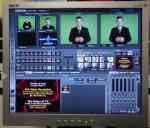 (by Matt Drabick)
(by Matt Drabick)
NewTek recently released the latest addition to their TriCaster family, the TriCaster STUDIO.
Building on the same video-mixing and live-presentation capabilities as the original TriCaster and later TriCaster PRO, the TriCaster STUDIO works with up to six external video sources, provides extremely-clean real-time chroma-keying with virtual sets support and other advanced capabilities.
Unlike previous TriCasters, which used a Shuttle PC as the host platform, the STUDIO is housed in a slightly larger and heavier (16 pounds versus 10) but still very portable box. The front of the STUDIO sprouts multiple video and audio connectors plus a pair of handles. The STUDIO allows up to six external video sources (video cameras, VCRs, DVD players, non-linear video editing systems, satellite feeds, etc.) to be connected and live-switched in real-time via composite, Y/C or component video inputs. Four separate Spicon balanced audio connectors are also provided, allowing the user to connect either XLR or quarter-inch phone inputs. Two composite, two Y/C and two component video outputs plus a pair of balanced phone and a pair of unbalanced RCA or phono audio outputs are available. All of the video and audio outputs are active at the same time. A FireWire and two USB ports are also located on the front of the STUDIO for connecting external drives or a DV source.


On the back of the STUDIO you’ll find standard keyboard, mouse and USB connectors plus another FireWire port and a dual-head video card. The VGA leg connects to a standard PC monitor to display the STUDIO software. The DVI leg passes the STUDIO’s live-switched output as digital data for connecting to a projector or large monitor.
Once launched, the STUDIO opens to the switcher screen. Unlike previous TriCasters which had dedicated on-screen preview monitors for every video source, the STUDIO only has monitors for its two DDRs, iVGA feed and waveform/vectorscope display. It does include on-screen monitors for the preview and program busses, so you can still see what is punched up on the preview channel before sending it to ‘air’.

The STUDIO includes not one but two DDRs, allowing video clips, animated titles, stills, full-screen graphics, etc. to be played back as switcher sources. While the STUDIO is still limited to a single DSK or overlay channel, both DDRs can be used as DSKs. Each DDR can be automatically cued to start and stop playing back when used as a switcher source.
Perhaps the biggest news with the STUDIO is its virtual sets support and vastly- improved chroma-keyer. Setting up the chroma-keyer is literally a one-button operation that results in a near-perfect key that requires little or no tweaking. If tweaking if required, intuitive tools are provided to remove any hint of a blue or green outline while maintaining image quality. Shadows can be preserved, resulting in an even more realistic chroma-key.

Five virtual sets are included with the STUDIO, each with multiple camera views. In other words, you can set-up a virtual set and switch between several live keys with glitch-free results. The scaling and chroma-keying required to digitally insert a subject between foreground and background layers is first-rate and clean. NewTek will probably offer additional virtual sets for the STUDIO plus tools for creating your own virtual sets. At least one third-party vendor is offering virtual sets that work with the STUDIO . . . go to www.virtualsetworks.com for details.
As useful as the STUDIO is for mixing multiple external video sources with graphics, titles and video clips, its ability to simultaneously distribute its output in multiple formats is equally impressive. You can output to composite, Y/C and component video with audio plus DVI, stream to the Internet and record to the STUDIO’s hard drive. This means you can feed a projector while recording to a standalone DVD recorder plus stream to the Internet while archiving a show to the internal hard drive. The STUDIO supports both push and pull streaming at various data and frame rates.
The STUDIO can also capture analog or digital video and audio to its hard drive for editing purposes using the composite, Y/C, component or FireWire connectors. A version of NewTek’s SpeedEDIT software is included that allows DV, HDV, AVI, QuickTime, MPEG-2, Flash, NewTek’s uncompressed RTV and compressed NT25 and other formats to be edited together or separately within the same project. Advanced color correction tools, intuitive storyboard and timeline editing modes, and 500 video transitions plus video and audio filters are included. Edited videos can be played back at the switcher and used for show openings or closings, plus interview, news or product segments.

By the addition of its improved chroma-keyer, six external video inputs, and virtual advanced sets support, NewTek has raised the bar yet again with its latest addition to the TriCaster family. With the STUDIO priced at $9,995.00 ($9,495.00 for educators) NewTek has once-again introduced a revolutionary product that the masses can afford.
Written by Kermit

